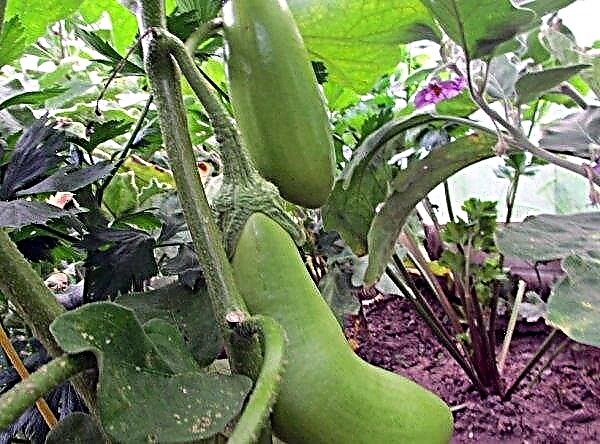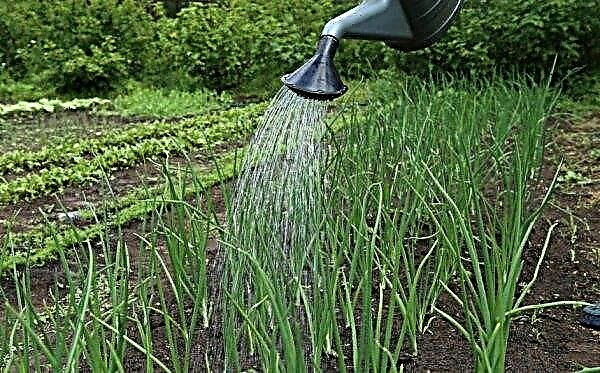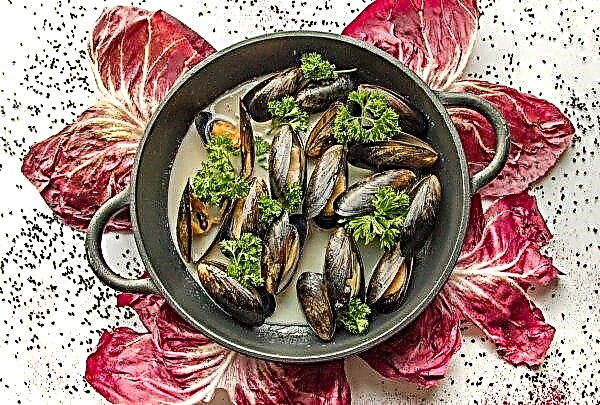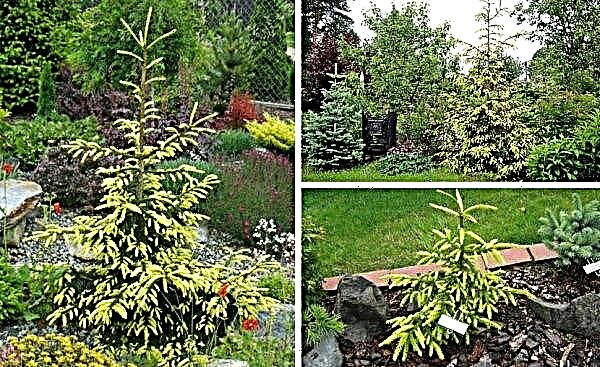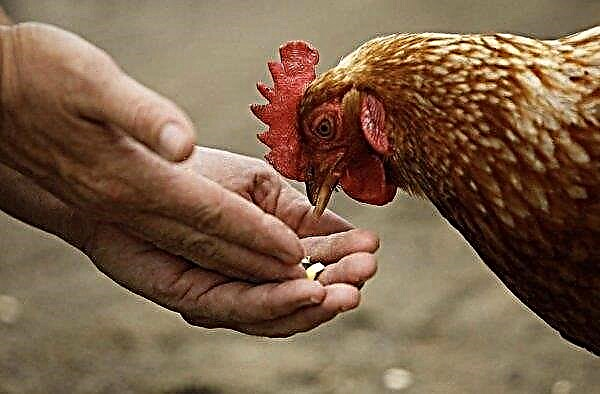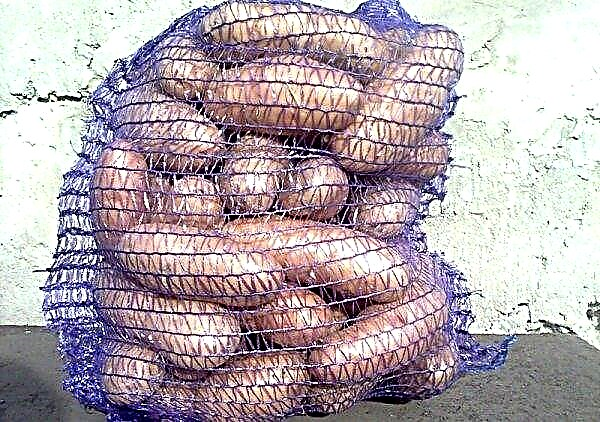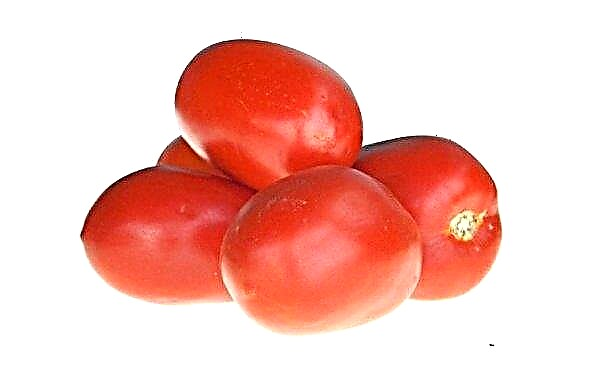Perhaps, nothing creates a cosiness in the house and gives it beauty, like decorative plants. The article will discuss the features of growing one of the aromatic decorative and deciduous plants - room mint.
Plant description
The scientific name for room mint is plectrantus. The people also nicknamed the plant a molar tree, Swedish ivy, and spore flower. The Latin name comes from the Greek words plectron - spur and antos - flower.
Did you know? The ancient Romans placed mint branches in pillows, because they believed that in this way you can achieve a healthy and calm sleep.
The plant is characterized by fragrant leaves, nondescript flowering, unpretentiousness in care, rapid growth and ease of reproduction.
| Root system | Powerful |
| Stem | Erect or creeping, 0.3–1.5 m high, tetrahedral, bare or covered with fluff |
| Leaf shape | One-piece, egg or elliptical, with serrations on the edges |
| Leaf color | Dark green |
| Flower shape | Bell-shaped, in umbellate and spikelet inflorescences |
| Flower color | White, blue, purple |
There are about 250–325 shrub and ampelous varieties of plectrantus. At home, peppermint, lemon, cat, Ertendahl and others are grown. Shporotsvetnik planted in pots, hanging baskets, used to decorate window frames, window sills, balconies, loggias, terraces.
Useful and harmful properties
- Plectranthus leaves secrete essential oils, have a persistent pleasant smell and have such beneficial effects:
- protect clothes and home decoration from moths;
- purify the air of pathogenic bacteria;
- improve sleep;
- relax the nervous system;
- reduce itching and inflammation on the skin with insect bites;
- when brewing eliminate sore throat;
- help with wet diathesis in children;
- accelerate the healing of diaper rash;
- assist in the complex treatment of childhood enuresis (in the form of baths);
- relieve nasal congestion and coughing.
- It is contraindicated to use folk remedies based on mint to such categories of people:
- pregnant
- lactating;
- children under 12 years old;
- prone to low blood pressure;
- with a diagnosis of varicose veins.
Did you know? Indonesians, Thais, Indians, Jamaicans and Cubans use room mint leaves for culinary purposes - they are added to various dishes as a spice.
How to choose a variety of homemade mint
If you have the opportunity to place a large flower in the house, then you can plant shrubby mint. Her bush reaches a height of 1 m. It has pubescent branches, beautiful wide oval leaves in the shape of hearts. This variety blooms in blue. Flowering lasts a long time.
For lovers of ampelous plants, the Erthendal spore flower will be interesting. Its shoots reach a length of 40 cm. It is distinguished by a beautiful color of leaves: the upper plate is dark green with white veins, the lower one is reddish.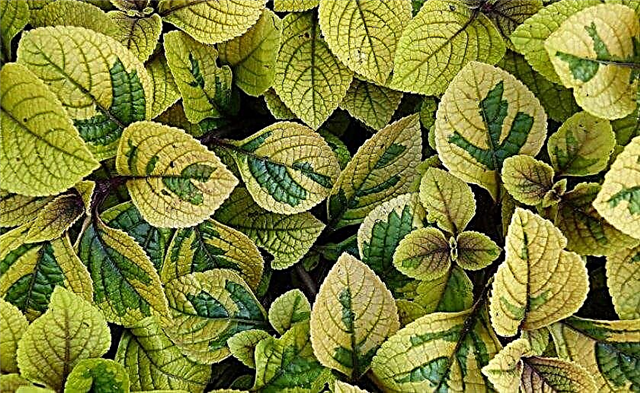 The flowers are light purple or white. For those who are sensitive to odors in the apartment, the southern plectrantus is suitable - its aroma is barely perceptible. This is an ampelous plant. It has rounded wax leaves that grow on long petioles.
The flowers are light purple or white. For those who are sensitive to odors in the apartment, the southern plectrantus is suitable - its aroma is barely perceptible. This is an ampelous plant. It has rounded wax leaves that grow on long petioles.
This variety is called Swedish ivy, because it is loved by the Scandinavians. If you need a compact plant, you can pay attention to the plektrantus felt. In indoor conditions, it does not grow above 30 cm.
Did you know? There is a belief that if you place a mint leaf in a purse, it will attract money to its holder.
Conditions for keeping
To understand what conditions are necessary for room mint, you should remember from which edges it comes from. A South African native prefers warmth, plenty of light and high humidity. Lighting is best done diffused, but at the same time bright. Avoid exposure to direct sunlight on the leaves is not worth it, as this can cause burns.
Mint feels best on the southwest side. Comfortable temperature for the flower is + 20–24 ° С in summer, at the level of + 15–16 ° С - in winter. The plant does not put forward special requirements for the level of humidity. Better if it is above 50-60%.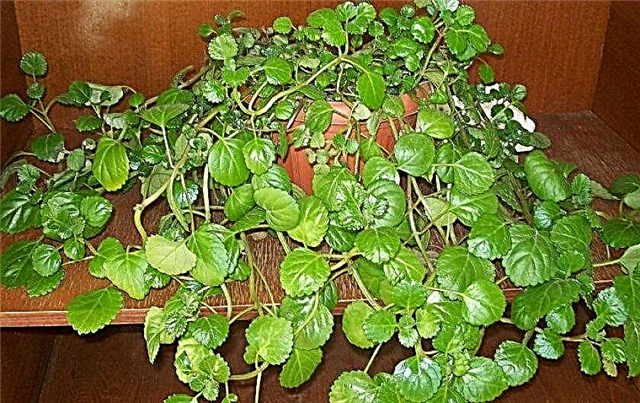
Home care and growing
To successfully grow indoor mint, you must follow the recommendations for caring for it.
You will need to regularly carry out such events:
- to water;
- spray;
- to feed;
- transplant.
Dredging and selection of containers for planting
Since indoor mint grows a powerful root system, you need to grow it in a deep and wide capacity. It can be made of plastic or ceramic. 1/3 it is filled with drainage. For planting plectrantus in a specialized store they buy soil intended for decorative and deciduous crops.
You can also cook it yourself by mixing:
- 2 parts of turf land;
- 1 part humus;
- 1 part of sheet land;
- 0.5 parts of peat;
- 0.5 parts of sand.
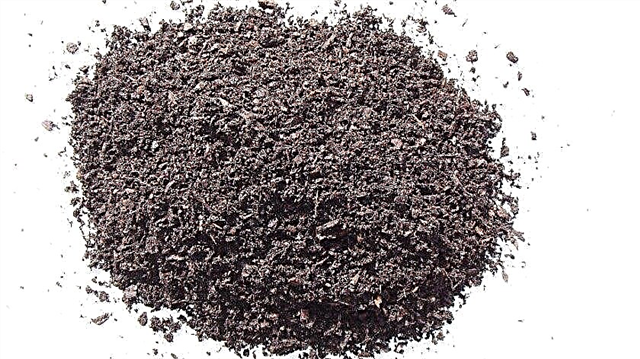 Before planting, a hand-made earth mixture must be decontaminated - pour it with a weak (pink) solution of potassium permanganate or calcine in the oven (microwave) at a temperature of + 70–80 ° С.
Before planting, a hand-made earth mixture must be decontaminated - pour it with a weak (pink) solution of potassium permanganate or calcine in the oven (microwave) at a temperature of + 70–80 ° С.Watering and fertilizer
The flower will need to be watered regularly. It is worth doing as soon as the top layer of the earth dries. In the summer, you need to moisten often and a lot. In winter - the amount and volume of humidification is reduced.
Water for humidification of house crops is taken filtered, settled, melt or rain. It should be at room temperature. In the summer months, when the temperature rises above +22 ° C, frequent spraying will be needed.
With short-term drought, the flower copes steadily. Leaves and shoots tend to accumulate moisture. Fertilize the flower monthly 2 times from spring to early fall. Top dressing is made with purchased fertilizers created for indoor plants.
Alternative alternating organic and mineral additives are also possible. No later than the beginning of October, feeding is stopped. This is necessary so that the plant accumulates nutrients for wintering and successfully wintered at rest.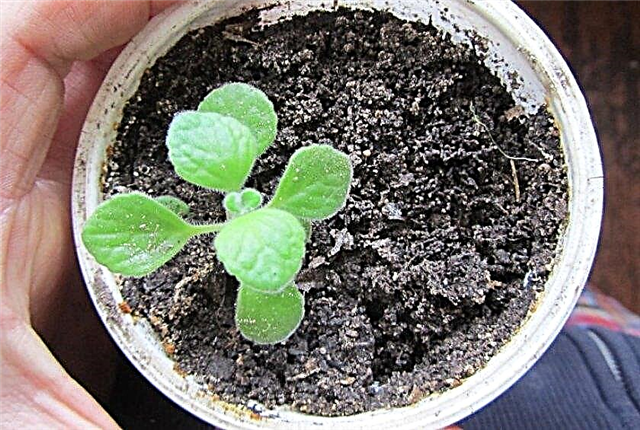
Pruning and transplanting
The formation of the bush by pruning is done in early spring. Remove weak, bare, damaged shoots, pinch the tops of the branches. Healthy shoots are shortened by 50%. This procedure will make the bush lush and neat.
After purchasing plants with a mint smell in the store, you need to transplant it. For landing, you should choose a larger tank.
Drainage is placed in it, which is covered with a nutrient substrate. The transplant is carried out by transshipment without destroying the land lump. In the future, the flower is transplanted 1 time per year until it reaches 5 years of age and 1 time in 2 years after overcoming this stage. Planned transplants produce in early spring.
Propagation of room mint
Plectrantus is propagated in 2 ways:
- The seeds.
- Cuttings.
Growing a flower from seeds is more troublesome. Seeds purchased at the store. They need to be planted in late February or early March. Seeds are planted to a depth of 0.5 cm. The soil will need loose. After sowing, the container is covered with glass, film or a plastic bottle.
You need to grow seedlings in a well-lit warm place. Until the first sprouts appear, it will be necessary to ventilate the plantings every day and regularly moisten the soil.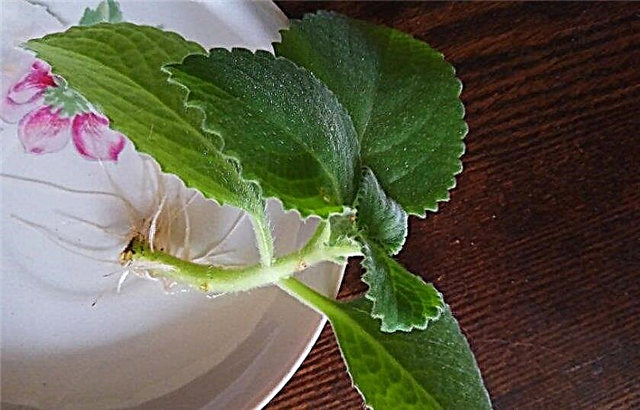 When young shoots appear, the shelter must be removed. After the first two leaves appear, the sprouts dive. After the formation of 5-6 leaves - transplanted to a permanent place. All this time, plants are watered and fed with universal fertilizers. Propagation by cuttings is much simpler.
When young shoots appear, the shelter must be removed. After the first two leaves appear, the sprouts dive. After the formation of 5-6 leaves - transplanted to a permanent place. All this time, plants are watered and fed with universal fertilizers. Propagation by cuttings is much simpler.
Cutting technology is as follows:
- Sanitize and sharpen a knife or scissors.
- Choose some strong, healthy shoots.
- Cut 6–8 cm cuttings at an angle of 45 degrees so that 2-3 leaves with internodes remain on them.
- Remove all buds and 2 lower leaves.
- Place the cuttings for drying in a shaded place to prevent decay.
- To process with rooting agent “Kornevin”.
- For rooting, place in water or plant in a nutrient substrate (universal soil with vermiculite and sand).
- Put in a room with room temperature.
- After the appearance of the roots (after about 2–4 weeks), plant the stalk in a pot.
Video: Rooting Plectrantus
How to collect
If the leaves of house mint are necessary for medical use, they must be cut off in the flowering phase - from July to August. It was at this time that they contained the most useful essential oil. Carefully cut branches with flowers or collect individual leaves.
Possible growing difficulties
If you do not arrange for the flower optimal conditions and regular care activities, then it will hurt and suffer from the attack of pests.
Important! If harmful insects or signs of the disease are detected on the flower, it is necessary to immediately isolate it from other plants and carry out treatment.
Pests
Household mint can be affected by such parasitic insects:
- Spider mite. The main sign of damage is the cobwebbing of the stem and leaves. A favorable condition for tick infestation is dry air. The fight against the parasite is carried out by wiping the leaves and the trunk with soap and water, dishwashing detergent, abundant watering and covering the bush with a film for 3 days, treating with Aparlo, Borneo, Floramayt, Flumayt acaricides.
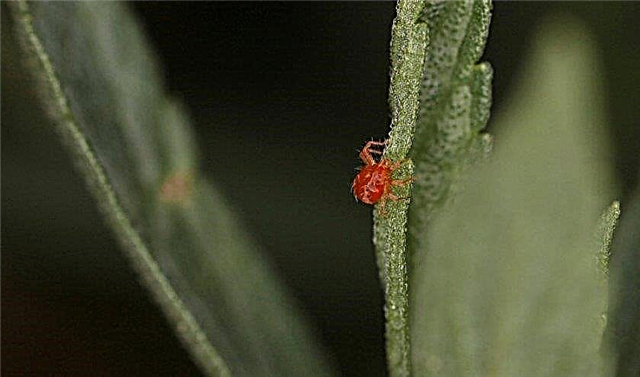
- Aphid. Symptoms of damage - drying out of leaves, wilting buds, the appearance of a pad on the leaves and stems. The destruction of the insect is performed by wiping with soap and water, alcohol, spraying with garlic, tobacco infusion, as well as infusions of wood ash, hot pepper, tomato tops. Of the chemicals used “Fitoverm”, “Iskra”, “Inta-vir”, “Actellik”, “Karate”, “Confidor”.
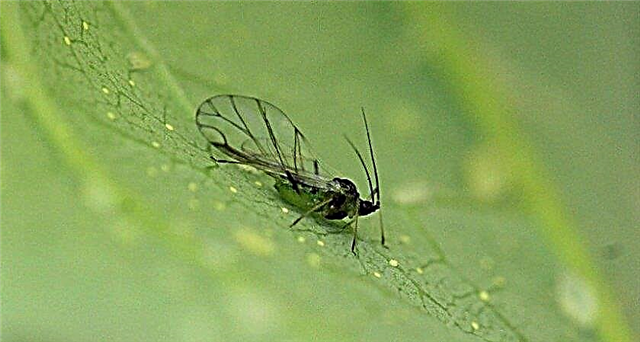
- Shield. This insect can be seen on the stem. It sucks nutrients from the plant, causing the flower to wither and disappear. The first symptoms of the appearance of the scale are sticky fluid on the trunk. To combat, use the mechanical method - scraping insects with a brush. Folk remedies - wiping with vinegar, garlic, pepper tinctures. In case of severe infection, they resort to chemical treatment using Fitoverm, Actellik, Metafos.
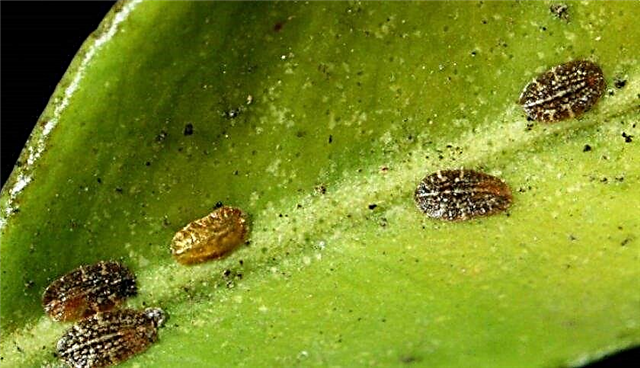
- Whitefly. It is difficult not to notice the whitefly. Moths with white wings are often found above the plant. However, the danger is not butterflies, but their larvae that feed on leaves. As a result, they turn yellow and curl. To combat whitefly, the above insecticides are used. Soap solution, tobacco and dandelion infusions also help scare away the insect.

Disease
Plectrantus is diagnosed with the following diseases:
- Downy mildew. It appears gray spots on the upper leaf plate and a gray coating on the bottom. The main reason is too abundant watering and high humidity. To get rid of the disease, it is necessary to eliminate the causes - to dry the earthen lump and air. For treatment, spraying leaves and stems with a mixture of serum (1 part) with water (3 parts) is used; a mixture of soap (40 g), soda (50 g) and water (10 l). With severe damage, it is necessary to use fungicides that are allowed for indoor plants: "Topaz", "Skor", "Dektra".
- Root rot. Manifested by yellowing and falling leaves. It develops in case of excessive moisture. The plant will need to be treated with fungicides and transplanted.
Important! When processing a flower with chemicals, it is necessary to adhere to the rules of personal safety. The treatment should be carried out in a well-ventilated area, protect eyes, nose, mouth, hands and body with special equipment. It is forbidden to consume drinks and food, smoke.
In addition to diseases, the plant may suffer due to errors in care. If he lacks something, it will signal this by changes in appearance. Most often, when growing peppermint, the following problems can occur:
- Stalk exposure, shredding of foliage. Occurs due to insufficient lighting. It is necessary to rearrange the flower in a lighter place or arrange artificial lighting.
- Lightening leaves. This is a sign of excessive lighting. It is necessary to protect the flower from sunlight.
- Falling leaves, wilting shoots. May indicate a lack of moisture. It is necessary to increase the amount and volume of moisture.
- Rotting of the roots, yellowing and falling leaves. May indicate excessive moisture. It is necessary to change the irrigation regime and reduce their volume.
- Lack of flowering and falling leaves. May occur when the flower is grown at too low a temperature.
So, indoor mint is a beautiful and unpretentious plant, for the cultivation of which a novice in flower business can take up. It is placed on the windowsill, with its help landscaped balconies, loggias, terraces. Grown in planters, pots and containers, in winter gardens.





